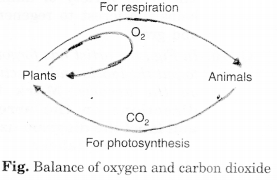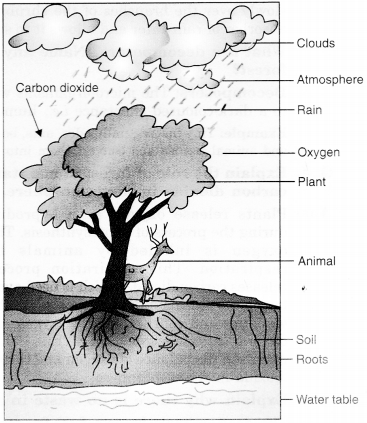NCERT Solutions for Class 7 Science Chapter 17 Forests: Our Lifeline are part of NCERT Solutions for Class 7 Science. Here we have given NCERT Solutions for Class 7 Science Chapter 17 Forests: Our Lifeline.
| Board | CBSE |
| Textbook | NCERT |
| Class | Class 7 |
| Subject | Science |
| Chapter | Chapter 17 |
| Chapter Name | Forests: Our Lifeline |
| Number of Questions Solved | 13 |
| Category | NCERT Solutions |
NCERT Solutions for Class 7 Science Chapter 17 Forests: Our Lifeline
Question 1.
Explain how animals dwelling in the forest help it grow and regenerate.
Answer:
Animals help in dispersing seeds of certain plants. The decaying animal dung also provides nutrients to the seedling to grow. This is how animals help the forest to grow and regenerate.
Question 2.
Explain how forests prevent floods.
Answer:
Raindrops in a forest do not hit the ground directly. The uppermost layer of the forest canopy intercepts the raindrops, and most of the water comes down up to soil through the branches and the stems of the trees. From the leaves, it drops slowly over the branches of the shrubs and herbs. Thus forests act as a natural absorber of rainwater and allow it to seep and therefore help in controlling floods.
Question 3.
What are decomposers? Name any two of them. What do they do in the forest?
Answer:
The micro-organisms which convert the dead plants and animals to humus are known as decomposers. Bacteria, mushrooms, etc. are decomposers. They decompose dead organisms and provide nutrients to trees.
Question 4.
Explain the role of forests in maintaining the balance between oxygen and carbon dioxide in the atmosphere.
Answer:
Plants release oxygen as a byproduct during the process of photosynthesis. This oxygen is inhaled by animals for respiration. This respiration process releases carbon dioxide which is used again by plants during photosynthesis. In this way, use and consumption of oxygen and carbon dioxide go on. Thus, they maintain the balance of oxygen and carbon dioxide in the atmosphere.

Question 5.
Explain why there is no waste in a forest.
Answer:
The decomposers decompose the dead organisms. The decomposed matter is absorbed by plants as nutrients. So, there is no waste in a forest.
Question 6.
List five products we get from forests.
Answer:
- Honey
- Wax
- Gum
- Herbs
- Wood.
Question 7.
Fill in the blanks:
- The insects, butterflies, honeybees, and birds help flowering plants in ……..
- A forest is a purifier of …….. and ………
- Herbs form the ………. layer in the forest.
- The decaying leaves and animal droppings in a forest enrich the ………..
Answer:
- pollination
- air, water
- lowest
- soil
Question 8.
Why should we worry about the conditions and issues related to forests far from us?
Answer:
Forests are very helpful for us. They clean air, play a vital role in the water cycle, provide various items, and so on. So, we should worry about the conditions and issues related to forests far from us.
Question 9.
Explain why there is a need for a variety of animals and plants in a forest.
Answer:
A variety of animals and plants are necessary for their survival and maintenance of the food chain. For example, the grass is eaten by insects, which in turn, are eaten by the frog. The frog is consumed by a snake which is eaten by an eagle. Thus it forms a food chain.
Grass ➜ insects ➜ frog ➜ snake ➜ eagle.
Many food chains can be found in the forest. All food chains are linked together. If anyone’s food chain is disturbed, it affects other food chains. Every part of the forest is dependent on the other parts. If we remove one component, say trees, all other commonest would be affected.
Question 10.
In Fig., the artist has forgotten to put the labels and directions on the arrows. Mark the directions on the arrows and label the diagram using the following labels: clouds, rain, atmosphere, carbon dioxide, oxygen, plants, animals, soil, roots, water table.
Answer:

Question 11.
Which of the following is not a forest product?
(i) Gum
(ii) Plywood
(iii) Sealing wax
(iv) Kerosene
Answer:
(iv) Kerosene.
Question 12.
Which of the following statements is not correct?
(i) Forests protect the soil from erosion.
(ii) Plants and animals in a forest are not dependent on one another.
(iii) Forests influence the climate and water cycle.
(iv) Soil helps forests to grow and regenerate.
Answer:
(ii) Plants and animals in a forest are not dependent on one another.
Question 13.
Microorganisms act upon the dead plants to produce
(i) sand
(ii) mushrooms
(iii) humus
(iv) wood
Answer:
(iii) Humus.
We hope the NCERT Solutions for Class 7 Science Chapter 17 Forests: Our Lifeline help you. If you have any query regarding NCERT Solutions for Class 7 Science Chapter 17 Forests: Our Lifeline, drop a comment below and we will get back to you at the earliest.